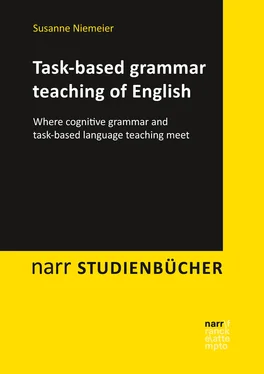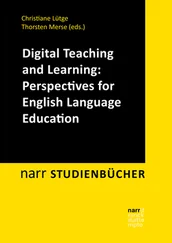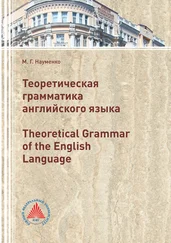Tasks usually focus a lot more on oral language than on written language2, although writing, listening and reading tasks can be used as well. The learners’ exposure to the target language should be maximised, providing them with opportunities for receiving comprehensible input as well as allowing and enabling them to produce meaningful output. Such meaning is not completely pre-determined, as it used to be in previous approaches, but to a certain extent the learners’ own meanings are what counts, i.e., the task just provides a framework and the learners are allowed to negotiate the task while doing it, for example, by adding their own creative ideas in order to make the task also personally meaningful for the individual learners and not only potentially meaningful for the whole class. According to VAN DEN BRANDEN/BYGATE/NORRIS (2009: 6), “the performance of functional tasks involving meaningful language use is the starting point, primary mechanism, and final goal of educational activity” and this is what task-based language teaching can contribute to.
R. ELLIS even goes so far as to claim that task-based teaching reflects
… the issues that figure predominantly in current discussions of language pedagogy – the role of meaning-based activity, the need for more learner-centred curricula, the importance of affective factors, the contribution of learner-training, and the need for some focus-on-form. Task-based pedagogy provides a way of addressing these various concerns and for this reason alone is attracting increasing attention. (R. ELLIS 2003: 33)
This view fully embraces the task-based approach and sees it as the ultimate solution for all pedagogical issues in foreign language instruction. Be that as it may, at least the current status of task-based instruction can definitely not be seen as the solution for all form-related and linguistic issues, which is why this book recommends some caution concerning R. ELLIS’ view and tries to add a linguistic perspective to the equation, not wanting to accept the vague expression “some focus-on-form” but instead arguing that grammar needs to be approached more systematically.
Some researchers (such as SKEHAN 1998, R. ELLIS 2003 or SAMUDA/BYGATE 2008) distinguish between task-based and task-supported language learning. In task-based language learning, the complete syllabus is structured around tasks whereas in task-supported language learning3, tasks are not the only method of instruction, although they can and should be one of the key elements in the foreign language classroom. With the German system in mind, this book therefore rather suggests task-supported teaching ideas, as it is of course not possible to change a complete syllabus and/or curriculum overnight, especially since no suitable textbooks are available and since the idea of a task-based syllabus still clashes with current assessment and evaluation practices and regulations. This may change over the course of time, but currently tasks can only be implemented every now and then, whenever the need arises, for example, when introducing new grammatical features. Therefore, whenever the term ‘task-based teaching’ appears in this book, it refers to what some scholars see as ‘task-supported teaching’4.
The task-based literature provides a variety of definitions of what a ‘task’ is, which are discussed in the following sub-chapter. What all definitions have in common is that they differentiate tasks from exercises, as tasks are to be seen in a wider context and as the outcome is not just a linguistic result but a solution for a problem, in the widest sense of this expression. Exercises, in contrast, are normally decontextualised and focus exclusively on a specific linguistic form, for example, on the transformation of given active sentences into the passive voice, or – to give a non-grammatical example – on writing a summary of a text without focusing on pragmatic notions or learner interests. R. ELLIS (cf. 2003: 3) sums up the difference between a task and an exercise quite convincingly by claiming that in tasks the learners act primarily as language users, whereas in exercises they act primarily as language learners.
2.1 The development of task-based language teaching
Presumably the first scholar who reported on having taught along the lines of what was going to be known as task-based language teaching was PRABHU, who describes his view of foreign language teaching as follows:
The development of competence in a second language requires not systematization of language inputs or maximization of planned practice, but rather the creation of conditions in which learners engage in an effort to cope with communication. (PRABHU 1987: 1)
In other words, second language acquisition happens in and through communicative activities and all the teacher needs to provide are opportunities for authentic, natural communication, which can be done by using tasks. PRABHU conducted an experimental project, the so-called ‘Communicational Teaching Project’ in Bangalore, in which especially the messages (i.e., the communicative content) were meant to be noticed by primary and secondary classes and not so much the structures, which were only paid incidental attention. The learners did not follow a syllabus consisting of a progression of linguistic structures but instead engaged in certain meaningful activities, in which tasks were used as a vehicle through which language was to be generated.
Today, task-based language teaching is not seen as one specific approach but rather as a “family of approaches that are united by two principles: First, meaning is primary, and second, there is a relationship between what learners do in the classroom, and the kinds of things they will need to do outside of the classroom” (NUNAN 2015: 13). In order to cater for these principles, the learners are confronted with well-organised tasks which they have to solve and which should be based on communicative needs in the real world. For example, if the communicative topic is ‘healthy food’1, the learners are not only provided with vocabulary and language structures relating to food (word fields, plural – s etc.) but are furthermore enabled to achieve goals that go beyond the classroom, namely to obtain food and drink in an English-speaking culture and to know about healthy nourishment – which, by the way, can additionally be seen as an example for the learner-centredness of task-based language teaching.
Although ‘tasks’ are the core of task-based teaching, there is no unanimous agreement on what a ‘task’ is. NUNAN (2015: 192) calls a task “the basic building block of the instructional design”. He differentiates between so-called ‘real-world tasks’ and ‘pedagogical tasks’ (NUNAN 1989). Real-world tasks (such as painting a fence, repairing a bicycle etc.) do not necessarily involve language, but as soon as they enter the classroom (for example, in the form of telling others how to paint a fence or how to repair a bicycle or making plans or shopping lists in preparation of performing such real-world tasks) they become pedagogical tasks. According to NUNAN, the aim that the learners are meant to reach is to convey meaning rather than to focus on grammatical form2. Most other researchers only mention the pedagogical tasks, not the real-world ones. Therefore, in what follows the term ‘task’ is only used to refer to pedagogical tasks. WILLIS, for example, one of the best-known proponents of task-based language teaching, offers a very wide definition of (pedagogical) tasks as “activities where the target language is used by the learner for a communicative purpose (…) in order to achieve an outcome” (1996: 23), which rules out most of the didacticised “communication” in a traditional classroom. The notion of a task achieving an outcome means that the learning is goal-oriented and leads – depending on the task – to a solution or to a product.
Читать дальше












